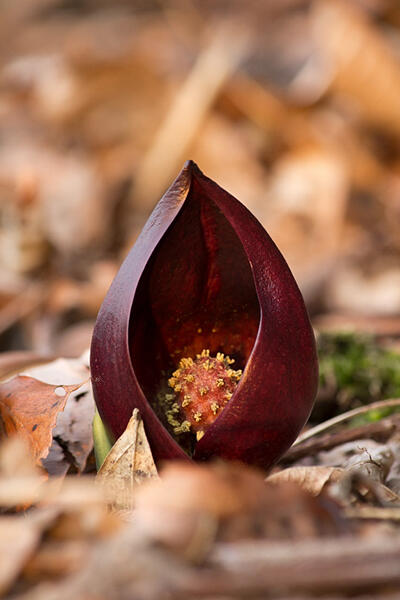There are nearly 100 species of thermogenic plants that can raise the temperature of their flowers. Researchers hypothesize that these plants are warmed by the heat generated by their flowers, spreading their scent and attracting insects that carry pollen. Symplocarpus renifolius is the only thermogenic species found in the cold regions of Northeast Asia. The plants produce a lot of heat, especially at night when the outside temperature is close to 0℃ immediately after the snow melts and maintain a core temperature of close to 20℃ during the week or so of flowering. By contrast, the closely related smaller-flowered Symplocarpus nipponicus does not show this characteristic. It was not known why Symplocarpus renifolius, unlike other thermogenic plants, produces heat in cold climates.

A research group led by Researcher Mitsuhiko Sato of the Department of Frontier Research and Development at Kazusa DNA Research Institute and Associate Professor Yasuko Inaba of the Faculty of Agriculture at the University of Miyazaki compared the native habitats of Symplocarpus renifolius and Symplocarpus nipponicus and their distribution information, recorded from museum specimens, with detailed environmental data. They found that the distribution of both species was determined by the amount of snow cover, with Symplocarpus renifolius growing in areas with deeper snow.
Using projected climate data from the last glacial period (i.e., the Last Glacial Maximum that occurred approximately 20,000 years ago), the researchers showed that during the Last Glacial Maximum, Symplocarpus renifolius was able to maintain a distribution closer to the present than Symplocarpus nipponicus. Additionally, the chloroplast DNA and nuclear DNA of Symplocarpus renifolius and Symplocarpus nipponicus individuals collected from different parts of Japan were examined, and Symplocarpus renifolius was found to be more genetically diverse.
These facts suggest that since the glacial period, the non/slightly thermogenic Symplocarpus nipponicus had migrated to its present distribution areas where the snow cover is suitable for its survival, whereas the high-heat-producing Symplocarpus renifolius had accumulated its present genetic diversity in the same areas to survive deeper snow cover. The present study provides clues to understanding the adaptive significance of why Symplocarpus renifolius produces heat in snowy regions and, more broadly, why thermogenic plants produce heat.
Further research is expected to shed light on the mechanisms of plant adaptation to the environment and lead to the development of methods for conserving plants under large-scale environmental changes. The results were published in the journal Ecology and Evolution.
Journal Information
Publication: Ecology and Evolution
Title: Potential contribution of floral thermogenesis to cold adaptation, distribution pattern, and population structure of thermogenic and non/slightly thermogenic Symplocarpus species.
DOI: 10.1002/ece3.10319
This article has been translated by JST with permission from The Science News Ltd. (https://sci-news.co.jp/). Unauthorized reproduction of the article and photographs is prohibited.




